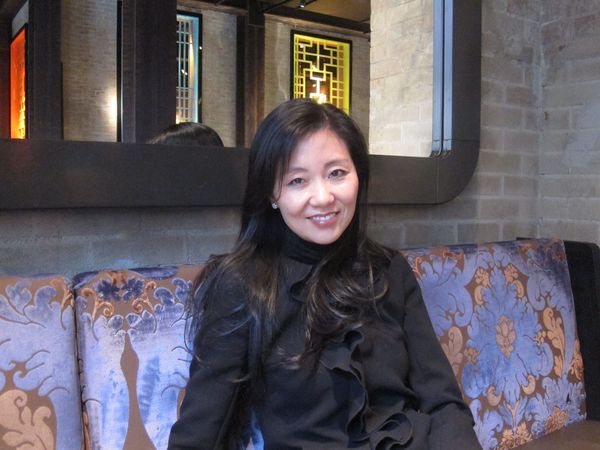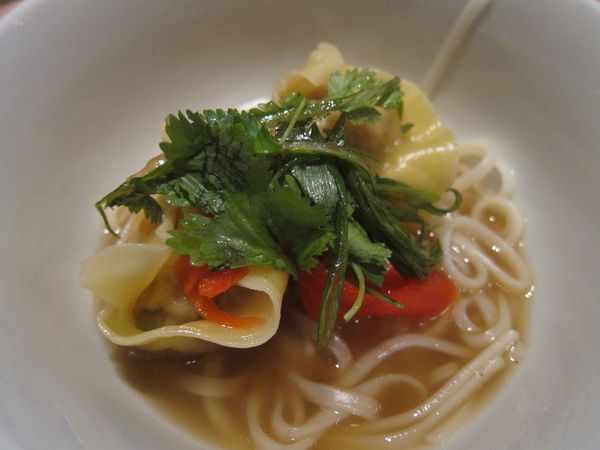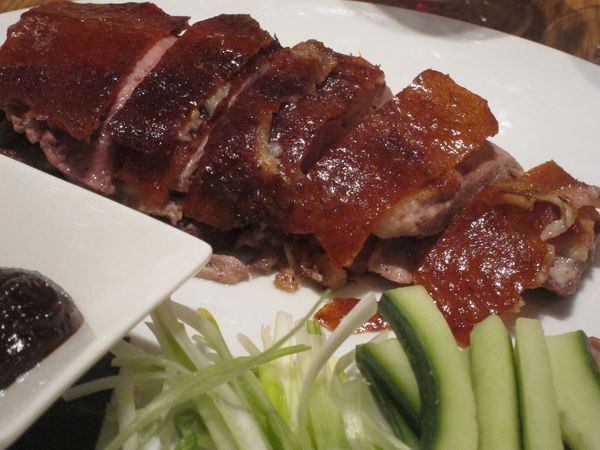
To many sommeliers around the world, Chinese food finds its most reliable winemate in German Riesling, the delicious white made from Riesling grapes all over Germany. Why? Chinese food is extremely diverse, and so is German Riesling: Whether the dish on the Chinese menu is sweet or savory, heavy or rich, there's always a German Riesling in a style that will conform. (Many mistakenly think that German Riesling is automatically sweet; in fact, most of the Riesling made and consumed in Germany is dry!)
Against this background of general collegial agreement, Hong Kong's Jeannie Cho Lee recently landed in New York City to host a lunch of German wines with Chinese food at Buddakan, an upscale, modern Chinese restaurant. And one of her main messages was: Germany, yes... but it's not just Riesling! In fact, Jeannie had a number of German Pinot Noirs up her well-tailored sleeve -- red wines! -- that she proved are also highly compatible with some styles of Chinese cooking.
It was epiphanal. It usually is.
Whenever Jeannie comes to talk, wine and food writers come to listen. Korean-born, Hong Kong-based, she brings extraordinary credentials to the table, having been gastronomic consultant for many top Asian restaurants and hotels for two decades -- and a consultant for Singapore Airlines as well, often lauded as the top service airline in the world. Furthermore, she writes regularly on gastronomic topics for the prestigious British wine magazine Decanter (where she is a contributing editor), and for the mass-circulation South China Morning Post in Hong Kong. To top it all off, though there are only 250 Masters of Wine in the entire world -- a title earned after a grueling England-based qualification period that can take as long as a decade -- Jeannie is one of them, and the only female Master of Wine from Asia.
At the Buddakan lunch, there were, of course, plenty of Rieslings to go around -- because nothing matches the flavors of slightly sweet Chinese food as precisely as an off-dry Riesling (the 2004 Riesling Kabinett from the Erdener Treppchen vineyard in the Mosel, produced by Meulenhof, was a multi-course wonder during the meal).
But the delicious menu offered the challenge of totally savory, non-sweet dishes as well. And, with Jeannie's guiding wisdom, several of them struck gastronomic gold with red wines (German Pinot Noir, in particular).
"When you get to the salty side of the Chinese taste spectrum," Jeannie told me -- "particularly when sweetness is absent, and particularly when the flavors of umami are at play -- the gentle red flavors of a Pinot Noir are just the trick." One of her favorite correspondences is soy sauce, when it dominates a dish, and Pinot Noir. "I recently ran a dinner in Scandinavia," she said, "where the diners far preferred their soy-sauce-dabbed sashimi with red wine over the white wine they usually drink."
Other Pinot-friendly Chinese-kitchen players in that salty-umami groove are oyster sauce, and black beans.
Jeannie demonstrated the latter by pairing up wine with a beautiful, soulful bowl of Black Bean Silken Tofu and Roast Duck Noodles -- a delicious broth flavored with ginger, offering a few meat-filled dumplings in addition to the marquee players. The wine? A Pinot Noir from the Pfalz, arguably German's best area for Pinot Noir: the 2004 "vom Muschelkalk" made by Rebholz, arguably Germany's best Pinot producer. A gentle thing, the wine was made richer by the soup, and reverberated particularly with the flavors of fermented black bean, ginger and meat. It was a match that flattered both the food and the wine.
The other ringing demonstration of Jeannie's Pinot principle came with the Peking Duck -- a particularly meaty version of the classic, but served with the traditional pancake-and-hoisin-sauce accompaniment. Many of us slathered that sweet hoisin on our pancakes, and found that an off-dry Riesling matched the sweetness best. But, at Jeannie's urging, we each made second roll-ups with much less sweet hoisin -- and found the 2008 Pinot Noir Kammerberg, from the Friedrich Becker winery in the Pfalz, to be a brilliant match with the duck.
The important take-away is: There's a reason behind all of this German Pinot Noir thinking. Now the third largest grower of Pinot Noir in the world, Germany (where the grape is called Spätburgunder) is turning out some of the world's most balanced and elegant Pinots.
The homeland of Pinot Noir, of course, is Burgundy, France -- and no one can deny that the world's greatest Pinots, maybe the world's greatest reds, come from there. But choosing red Burgundy for Chinese food may be a little trickier than choosing German Spätburgunder. The latter, because of Germany's cold climate, is often in an elegant, food-loving style. Some red Burgundies (the famous and expensive ones) may be too rich for the food; some red Burgundies (the cheaper ones) may be too lean for the food; and some revered older Burgundies may be too subtle for the food.
These problems echo throughout the Pinot Noirs of the world. Some great ones, for example, are being produced in California and Oregon -- but wines like these tend to get more of everything, starting with the ripening sun. "Avoid intensely fruity, high alcohol or oaky styles of Pinot Noir that will compete," Jeannie points out.
In fact, the only other Pinot place in the world that I count on to make balanced red wines that will reliably go with savory, umami-inflected Chinese food is New Zealand -- particularly the Pinot-Noir-growing regions of Central Otago, Canterbury, and Marlborough.
Of course, Jeannie Cho Lee realizes full well that selecting wine for Chinese food has a difference; you are rarely selecting a wine for one dish (as you do in European cuisines), but usually selecting a wine to cover multiple dishes in the same course. She is very practical about this sommelier hump. She advises that the best white across the board is Riesling ("dry-style, with sufficient body and weight")... and the best red, of course, is Pinot Noir ("a medium-bodied elegant one with low-to-moderate tannins.")
Lightness and elegance rule. If you can pick your chunky wine up from the glass with chopsticks... you've got the wrong wine!


